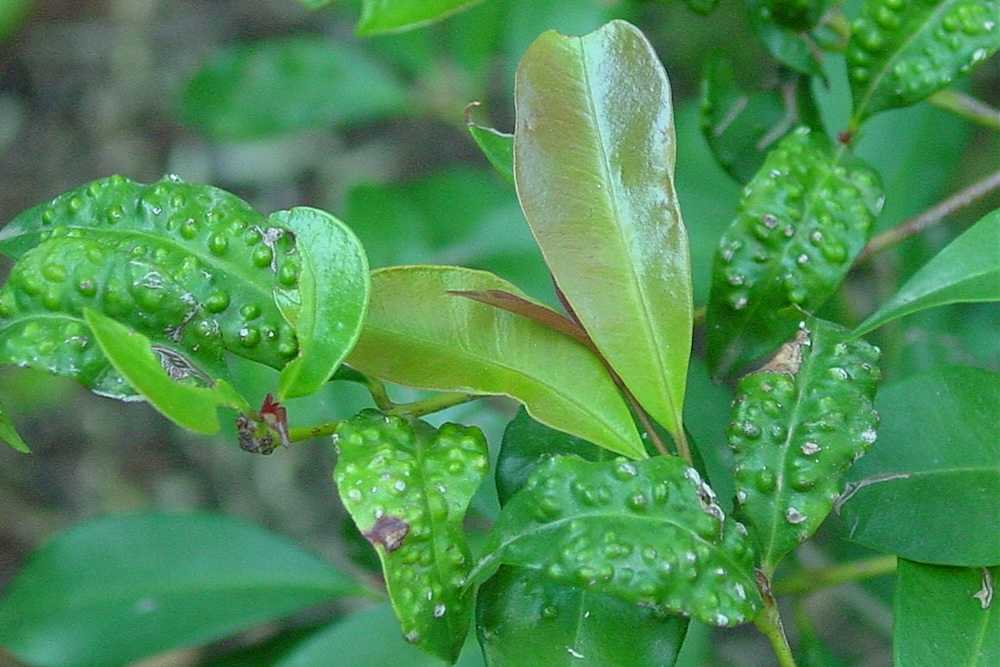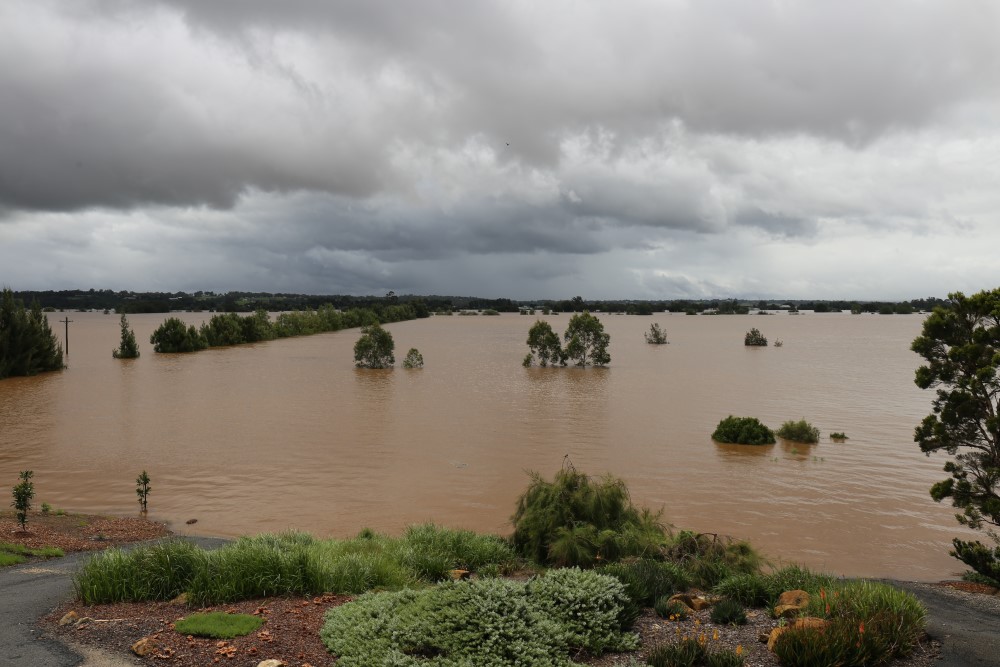In this article, we’ll delve into the world of aphids, scale and psyllids by understanding their life cycles, behaviours, and the harm they can inflict on lilly pilly plants.

Summary – Survivability of Different Landscape Plants in Various Wet Feet Conditions
Buffer Plants
Best performers over all categories of waterlogging.
Saturated Soils, Bio-retention swale, and Flood testing.
Based on this research these are good choices for waterlogging, for non-emergent drought tolerant plants, meaning they can handle wet and dry, but not for permanent wetland water bodies.
Confidence is higher for these plants in any Landscape, whether dry or wet, or excessively irrigated, as they provide a buffer for extreme weather or poor irrigation practices.
| Slim™ Callistemon viminalis ‘CV01’ PBR | Macarthur™ Callistemon viminalis ‘LC01’ PBR |
| Better John™ Callistemon viminalis ‘LJ1’ PBR | Green John™ Callistemon viminalis ‘LJ23’ PBR |
| Yalba™ Imperata cylindrica | Isabella® Liriope muscari ‘LIRF’ PBR |
| Just Right® Liriope muscari ‘LIRJ’ PBR | Amethyst™ Liriope muscari ‘LIRTP’ PBR |
| Katie Belles™ Lomandra hystrix ‘LHBYF’ PBR | Lucky Stripe™ Lomandra hystrix ‘LMV200’ PBR |
| Shara™ Lomandra fluviatilis ‘ABU7’ PBR | Evergreen Baby™ Lomandra labill ‘LM600’ PBR |
| Tropic Cascade™ Lomandra hystrix ‘LHWP’ PBR | Cosmic Pink™ Rhaphiolepis indica ‘RAPH02’ PBR |
| Cosmic White™ Rhaphiolepis indica ‘RAPH01’ PBR | Grey Box™ Westringia fruticosa ‘WES04’ PBR |
| Mundi™ Westringia fruticosa ‘WES05’ PBR | Mundi™ Nafray® Pennisetum alopecuroides |
Evaluation of Survivability of Different Landscape Plants in Various Wet Feet Conditions
Adajar, C.A.M.M.1, Tulipan, J.2, Layt, T.3
Extreme flooding and wet soil testing of many plant types at Ozbreed was conducted over a 10 year period, with the last few years encompassing a period of 6 flood events.
Introduction
Rapid urbanisation has had a negative impact on ecosystems, and has altered land use which has caused wheather extreemes to be maginfied to produce more flooding and often more wet soils. Hard surfaces send water to soft landscapes, where they are often wet due to run off for far longer than the planners intended, especially when prolonged wet weather occurs as it did in 2020-2023.
This study aims to identify which plant species can survive in extreme wet conditions for more resilient landscapes in the face of increased flooding in Australian developments.
The plants that thrived in the real world flooding or wet soils in this study when used will provide a wet survivability buffer for Landscape Designers and Architects and other Landscape prefessionals.
Adding usability to the plants, most in the study are also very drought tolerant, including many natives.
The study also helped determine which type of Lomandra species are suitable for heavy wet soils and to identify the plants suitable for Australian bio-retention swales and rain gardens.
Litreture study highlights of relevant information.
Floods cause significant impacts on vegetation, with effects varying depending on the crop species and parameters present. Plant mortality increases at higher temperatures due to oxygen depletion, while erosion raises the risk of plant loss during floods through shear stress.
The age of a plant also affects its survivability, with newly germinated and older seedlings being more susceptible to flooding. Flood velocity has a direct impact on plant mortality rates. Plants can survive inundation better if they are not fully submerged.
Methodolgy
Three testing areas were considered to study the survival of various plant species.
Testing area 1 had frequently saturated heavy clay-type soil and focused on wet feet conditions.
Testing area 2 was a bio-retention swale, aiming to clean water of nutrients and contaminants.
Testing area 3 was a floodplain trial ground, focusing on plants that can adapt in landscapes with frequent flooding. 6 floods occurred from 2020 to 2022.
Statistical analysis using two-way ANOVA and Pearson correlation coefficients was conducted to determine the factors affecting plant survival.
Results
Testing Area 1; heavy clay-type soil and extreeme wet feet conditions.
Plant trials
- Large numbers of Evergreen Baby, and Shara Lomandra, and smaller numbers of the soon to be released Shara blue, and Lady Tanika Lomandra and Blue Horizon™ Eremophila glabra had a 100% survival rate. Lomandra hystrix had 100% survival in 1 trial, and 67% in another trial.
- Common and many commercial types of Lomandra confertifolia (50% survival) and Lomandra longifolia (33% survival) performed poorly.
- New, untested Lomandra breeding plants had a 61.29% survival rate
- Large numbers Liriope including Evergreen Baby, Just Right, Isabella, Silver Lawn, Pink pearl thrived in wet parts of Area 1.
Root rot treatment trial.
- Trial tested root rot treatments on Tanika Lomandra longifolia, known for thriving in dry slopes and flat areas and temperate wet, but struggling in humid, wet conditions. The trial year was humid, the soil extra wet and Phytpothera was present.
- 8 plants were in each treatment. Agri-Fos treatment resulted in 0% survival, indicating ineffectiveness against root rot diseases in Tanika. Control group showed a 25% survival rate, while Phyto guard and Rhizovital treatment had a 62.5% survival rate.
- For humid wet soils with root rot diseases, treating Tanika Lomandra longifolia with 1 g/L Phyto guard and 4 mL/L Rhizovital increases survival rate.
Testing Area 2; Plants tested in a Bio retention swale that recieved regular water runoff from nursery irrigation.
- Exotic non-invasive plants to thrive in the trial for 9 years were Amethyst and Just Right Liriopes, and Cosmic and Cosmic Pink Rhaphiolepis.
- Nara Native Turf did well for 5 years, and then it modified, as it allowed wetland plants to grow and shade it partially out, but it was still there providing some erosion control.
- Native plants to thrive in the Bio-oretention swale for 9 years were Callistemons Better John, Green John, Macarthur, and Slim, and Lomandras Shara, Lucky Stripe, and Tropic Cascade, whilst Tanika Lomandra which is typical of most Lomandra with extreeme wet feet had all plants die. Westringia Naringa, Aussie Box and Low Horizon which behave similarly to most Westringia in extreme wet feet died. Westringia Mundi and Grey Box Thrived.
- Many plants died in the trial including all Dianella, Tristianopsis, and others.
Testing Area 3; Survivability of various plant types in floodplains.
- Seven Acacia varieties were planted in the floodplain. Most plants survived the first flood, but subsequent floods killed most. Only 5 out of 7 Acacia implexa survived all floods, and it was the only species that was replicated and generally did well. Two selections of A.implexa thrived, and selections of those could be useful.
- Mature common Agapanthus had a 100% survival rate in 3 floods, while the less mature Agapanthus breeding trial had an 86.21% survival rate.
- Three varieties of Pennisetum alopecuroides were grown and all did well through 4 to 5 floods. Many months very young Pennisetum alopecuroides died, showing plants at least need to be established to survive.
- From 10 selections only 3 Bufflao types survived, and only 1 type thrived.
- 6 types of Callistemon thrived in multiple floods, proving to be one of the most successful shrib types.
- Large numbers Casuarina types with mature plants survived multiple floods: Casuarina cunninghamiana (five floods) and Casuarina glauca on a little higher ground (four floods).
- One Cordyline type with three mature plants survived four floods.
- All semi-mature Cupaniopsis anacoides survived 2 to 4 floods.
- Five Dianella varieties of mature plants endured the floods well.
- Eremophila Blue Horizon and Fraxinus Griffithii each had one type, both surviving their respective one and three floods.
- Eucalyptus spp experienced five floods, with two out of four plants dying.
- Multiple Gardenia plants experienced four floods, with only one dying. All Gazania died.
- Only 1 Hibertia scandens survived multiple floods, and another survived all but the big one. These two have been selected to commercialise.
- Imperata Yalba variety thrived after five floods.
- Kunzea baxteri had one healthy survivor out of five semi-mature plants after one flood, showing potential for breeding flood-resistant plants.
- Large numbers of Isabella and Just Right Liriope, survived five floods in the low part of the floodplain proving water submersion resilience.
- Lomandra had fourteen varieties that were flooded multiple times, most being new breeding. Three types died. Shara and Tropic Cascade thrived in large plantings. Tanika Lomandra survived the floods well.
- Two common Magnolia were in the floodplain: younger plants had a 50% survival rate after five floods, while all mature plants survived two floods.
- Melaleuca plants had four types; three mature types survived flooding, but only one semi-mature Melaleuca nesophila breeding selection thrived after three floods.
- Murraya plants, all mature, mostly thrived after four floods, with only one observed as dead or dormant.
- Both Myoporum insulare and Yareena™ Myoporum did not do well after the large floods.
- Three varieties of Nandina survived two floods, namely Blush Nandina, Flirt Nandina and Obsession Nandina.
- All Green Mist Phormium survived 4 floods, whist the Sweet Mist Phormium had one survivor plant after four floods.
- Two Rhaphiolepis varieties, and two westringia types survived 3 to 4 floods.
- Zen grass Zoysia thrived in 4 floods, whilst Zoysia tenuifolia sufferd badly but survived, and 6 out of 9 types of zoysia died. Nara and Empire survived in a seperate area.
- A flood plain turf grower survey showed Empire Zoysia, Nara Native Zoysia, and Couch turf survived floods well, while Buffalo grass had mixed results, and Kikuyu generally struggled.
- Statistacally a pearson correlation table showed that the smaller the number of floods the plant experiences, the better chance the plant will survive.
Rapid urbanization has led to significant environmental issues, including biodiversity loss, erosion, nutrient shedding, and waterlogging. Addressing these problems requires careful landscape planning, particularly the selection of plants resilient enough to withstand extreme conditions and contribute to biodiversity restoration. The study tested the survivability of different landscape plants in extreme wet conditions across three testing areas.
The research involved three testing areas, each exhibiting different conditions. In the first area with heavy clay-type soil and constant water saturation, two Lomandra varieties, Evergreen baby and Shara, were found to thrive, showing a 100% survival rate. Furthermore, treatments against root rot diseases using Phyto guard and Rhizovital increased the survival rate of Tanika Lomandra longifolia plants by up to 62.5%.
The second testing area simulated bio-retention swale conditions, where the health and survivability of different varieties of Rhaphiolepis, Lomandra, and Westringia varied. Plant age was found to inversely correlate with plant health, with younger Pennisetum plants dying and older ones living. These findings provide vital guidance for landscape planners working in urban environments with wet conditions.
The last testing area was a floodplain where different plants were grown experienced multiple floods. The results showed that many plants survived the numerous floods and thrived, whilst a number of plants died or had poor health.
Recommendation
This study provided significant data regarding which landscape plants to use in extreeme wet feet conditions.
Future studies could be conducted regarding the mechanism of how these plants adapt and survive these conditions, as well as evaluation utilising similar testing methods with a larger selection of plants.
Full Paper
For the full paper, click here.




This Post Has 0 Comments